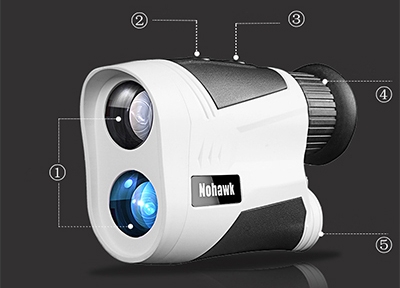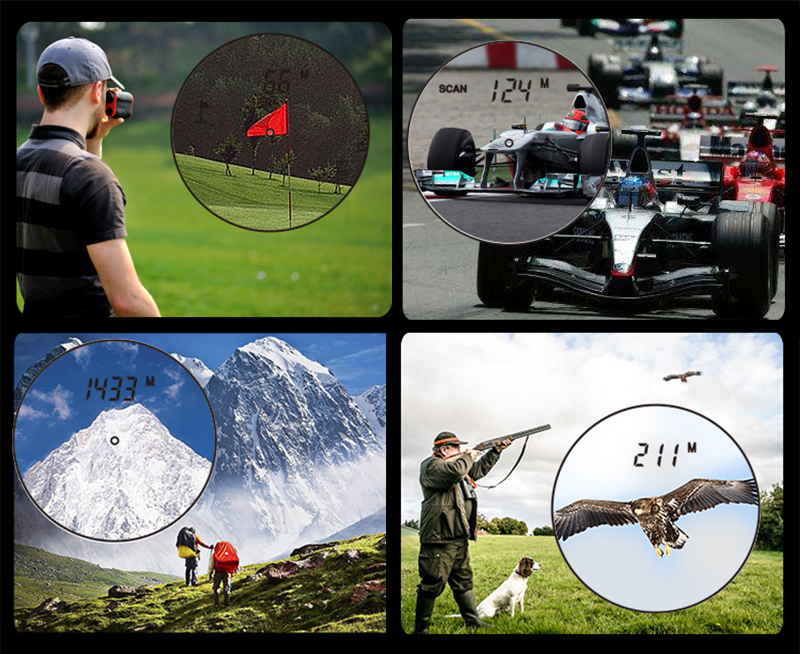Reliable laser rangefinder comes with 6X magnification and 24mm objective lens. Measuring up to 850 yards with continuous scan mode, suitable for golf, hunting, speed measuring and other outdoor activities measurement.

Laser rangefinder details
- Objective Lens
- Mode
- Power Key
- Eyepiece
- USB Charging
Application
Laser rangefinders are widely used in topographical surveys, battlefield surveys, tanks, aircraft, ships and artillery to measure the distance of targets, and to measure the height of clouds, aircraft, missiles and artificial satellites. LRF is an important technical equipment to improve the accuracy of high tanks, aircraft, ships and artillery. Due to the continuous reduction in the price of laser range finders, laser range finders have gradually begun to be used in industry, which can be widely used in industrial measurement and control, mines, ports and other fields.

| Model | SISCO-800m |
| Distance Measuring Range | 850 Yard |
| Measuring Accuracy | ±1 Yard |
| Display | LCD |
| Magnification | 6X |
| Objective Lens | 24mm |
| Focus Way | Eyepiece focus |
| Operating Temperature | -10℃-50℃ |
| Laser Type | 905nm, FDA Class 1 |
| Measuring Mode | Normal ranging (scan mode, flag mode) |
| Power | CR-2 battery 3V |
| Size (L*H*T) | 103*74*41mm |
| Weight | 200g |
Q1: How does a laser rangefinder work?
A1: The Laser Rangefinder uses a laser beam aimed at the target to determine its distance. A laser is beamed to the target, like the pin, and reflects back to the rangefinder. The time in which it took the laser to reflect back to the device is used to calculate the distance.
Q2: What is a laser rangefinder?
A2: LRF or a Laser Range Finder is a device used to measure distances. Most laser rangefinders operate on the time of flight principle by sending a laser pulse in a narrow beam towards the object and measuring the time taken by the pulse to be reflected off the target and returned to the sender.
Q3: What is the range of a laser rangefinder?
A3: Laser rangefinders let you take measurements both indoors and outdoors with 1 mm per kilometre accuracy. Professional construction laser rangefinders can measure distance of up to approximately 150 metres. Long-range rangefinders can measure distance of up to 1500 metres.
Tips: Laser rangefinder troubleshooting
The field of view is dark and nothing can be seen:
- If your eye is too close to the eyepiece of a digital laser rangefinder, your field of view will be dark.
- Keep your eyes away from the eyepiece and look for a stable view. In most cases, approximately 10mm to 15mm is appropriate.
When the power is off, the field of view is shaking:
- For rangefinders equipped with the STABILIZED function, the field of view will be shaking when the power is turned off.
- It is a phenomenon caused by the internal structure, not a failure. When the power is turned on, the shaking stops.
The actual distance indicator does not blink:
- Models equipped with this feature allow the user to turn the mode ON/OFF of the Actual distance indicator.
- Please change the setting from OFF to ON according to the instruction manual of laser rangefinder.
- It blinks only when the measurement display mode is D mode (actual distance).
Thank you for buying industrial test and measurement equipment on SISCO.com, all products sold by SISCO and the partner cover a 12 months warranty, effective from the date of receiving the products.
What is covered?
SISCO is responsible for providing free spare parts, and free technical support to assist the customer to repair the defective products until the problem is solved.
What is not covered?
- Product purchased from anyone other than a SISCO store or a SISCO authorized reseller.
- Expendable parts.
- Routine cleaning or normal cosmetic and mechanical wear.
- Damage from misuse, abuse or neglect.
- Damage from use of parts other than SISCO approved.
- Damage from use outside the product’s usage or storage parameters.
- Damage from use of parts not sold by SISCO.
- Damage from modification or incorporation into other products.
- Damage from repair or replacement of warranted parts by a service provider other than a SISCO authorized service provider.
- Damage caused by the application environment not meeting the product usage requirements and the failure to perform preventive maintenance.

